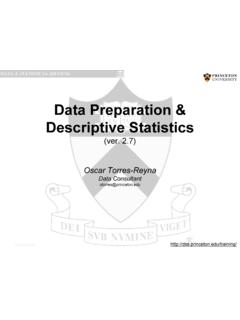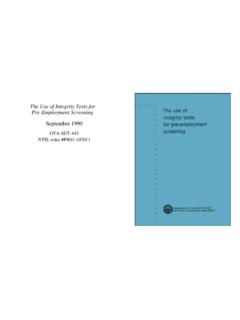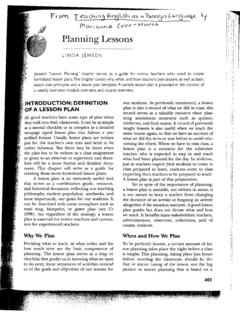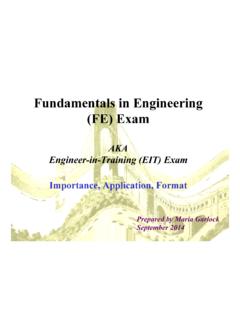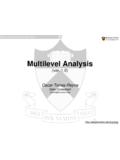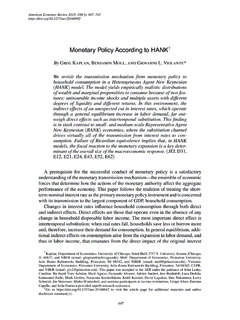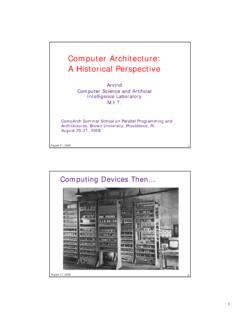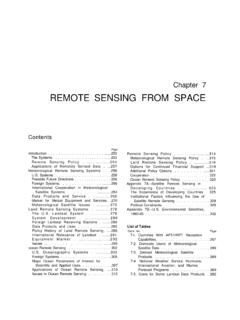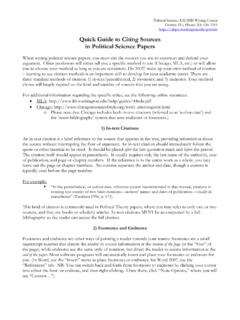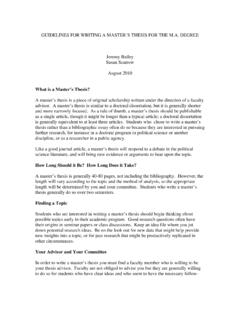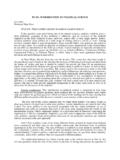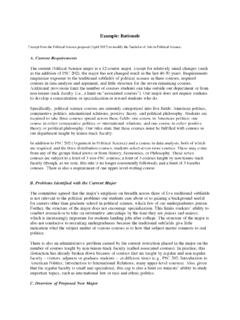Transcription of Political Game Theory - Princeton University
1 Political Game Theory Nolan McCarty Adam Meirowitz To Liz, Janis, Lachlan, and Delaney. Contents Acknowledgements vii Chapter 1. Introduction 1. 1. Organization of the Book 2. Chapter 2. The Theory of Choice 5. 1. Finite Sets of Actions and Outcomes 6. 2. Continuous Outcome Spaces* 10. 3. Utility Theory 17. 4. Utility representations on Continuous Outcome Spaces* 18. 5. Spatial Preferences 19. 6. Exercises 21. Chapter 3. Choice Under Uncertainty 23. 1. The Finite Case 23. 2. Risk Preferences 32. 3. Learning 37. 4. Critiques of Expected Utility Theory 41. 5. Time Preferences 46. 6. Exercises 50. Chapter 4. Social Choice Theory 53. 1. The Open Search 53. 2. Preference Aggregation Rules 55. 3. Collective Choice 61. 4. Manipulation of Choice Functions 66. 5. Exercises 69. Chapter 5. Games in the Normal Form 71. 1. The Normal Form 73. 2. Solutions to Normal Form Games 76.
2 3. Application: The Hotelling Model of Political Competition 83. 4. Existence of Nash Equilibria 86. 5. Pure Strategy Nash Equilibria in Non-Finite Games* 93. 6. Application: Interest Group Contributions 95. 7. Application: International Externalities 96. iii iv CONTENTS. 8. Computing Equilibria with Constrained Optimization* 97. 9. Proving the Existence of Nash Equilibria** 98. 10. Strategic Complementarity 102. 11. Supermodularity and Monotone Comparative Statics* 103. 12. Refining Nash Equilibria 108. 13. Application: Private Provision of Public Goods 109. 14. Exercises 113. Chapter 6. Bayesian Games in the Normal Form 115. 1. Formal Definitions 117. 2. Application: Trade restrictions 119. 3. Application: Jury Voting 121. 4. Application: Jury Voting with a Continuum of Signals* 123. 5. Application: Public Goods and Incomplete Information 126.
3 6. Application: Electoral Competition under Uncertainty 127. 7. Application: Campaigns, Contests and Auctions* 131. 8. Existence of Bayesian Nash equilibria* 133. 9. Exercises 134. Chapter 7. Extensive Form Games 135. 1. Backward Induction 138. 2. Dynamic Games of Complete but Imperfect Information 140. 3. Subgame Perfection and Perfect Equilibria 144. 4. Applications 145. 5. Exercises 158. Chapter 8. Dynamic Games of Incomplete Information 161. 1. Perfect Bayesian Equilibria 163. 2. Application: Entry Deterrence in Elections 172. 3. Application: Information and Legislative Organization 178. 4. Application: Informational Lobbying 183. 5. Refinements of Perfect Bayesian Equilibrium* 186. 6. Exercises 195. Chapter 9. Repeated Games 199. 1. The Repeated Prisoner's Dilemma 200. 2. The Grim Trigger Equilibrium 202. 3. Tit-for-Tat Strategies 203. 4.
4 Intermediate Punishment Strategies 204. 5. The Folk Theorem* 206. 6. Application: Interethnic Cooperation 208. 7. Application: Trade Wars 213. 8. Exercises 215. CONTENTS v Chapter 10. Bargaining Theory 217. 1. The Nash Bargaining Solution 217. 2. Non-cooperative Bargaining 222. 3. Majority Rule Bargaining Under Closed Rule 226. 4. Bargaining with Incomplete Information 234. 5. Application: Veto Bargaining 235. 6. Application: Crisis Bargaining 244. 7. Exercises 254. Chapter 11. Mechanism Design and Agency Theory 257. 1. The Mechanism Design Problem 260. 2. Applications 263. 3. Incentive Compatibility and Individual Rationality 274. 4. Constrained Mechanism Design 276. 5. Mechanism Design and Signaling Games 291. 6. Exercises 295. Chapter 12. Mathematical Appendix 299. 1. Sets and Functions 301. 2. The Real Number System 304. 3. Points and sets 306.
5 4. Continuity of Functions 308. 5. Correspondences* 310. 6. Calculus 311. 7. Probability Theory 324. Bibliography 335. Acknowledgements The origin of this book lies in the utter inability of either of its authors to write legibly on a black board (or any other surface, for that matter). To save our students from what would have been the most severe form of pedagogical torture, we were forced to commit our lecture notes to the electronic form. This also compensated for our inability to spell without the aid of a spell We ultimately decided that all of the late nights spent typesetting game Theory notes should not go in vain. So we undertook to turn them into this book, which of course, led to more late nights spent typing. We hope these weren't wasted either. We are most grateful to the students at Columbia and Princeton on whom early versions of our notes and manuscript were inflicted.
6 Puzzled looks and panicked o ce hours helped us to figure out how convey game Theory to students of politics. We also benefited from early conversations with Chris Achen, Scott Ashworth, Larry Bartels, Keith Krehbiel, David Lewis and Thomas Romer on what a book on Political game Theory ought to look like. Along the way Stuart Jordan and Natasha Zharinova have provided valuable assistance and feed- back. Finally, our greatest debts are to those who taught us Political game Theory : David Austen-Smith, Je rey Banks, David Baron, Bruce Bueno de Mesquito, Thomas Romer, and Howard Rosenthal. Nolan McCarty Adam Meirowitz Princeton NJ. 1. Our mispelling styles are quite distinctive, however. For a given word, Mc- Carty uses completely random spellings while Meirowitz consistently mispells the word in the exact same way. vii CHAPTER 1. Introduction In a rather short period of time, game Theory has become one of the most powerful analytical tools in the study of politics.
7 From its ear- liest applications in electoral and legislative behavior, game theoretic models have proliferated in such diverse areas as international secu- rity, ethnic cooperation, to democratization. Indeed all of the major fields in Political science have been the recipients of important contri- butions from Political game theoretic models. Rarely does an issue of the American Political Science Review, the American Journal of Po- litical Science, or International Organization appear without at least one article formulating a new game theoretic application to politics or providing an empirical test of an existing one. Nevertheless, applications of game Theory have not developed as fast as they have in economics. One of the consequences of this un- even development is that most Political scientists who wish to learn game Theory are forced to rely on textbooks written by and for econo- mists.
8 While there are many excellent economic game Theory texts, their treatments of the subject are often not well-suited to the needs of many Political scientists. First and perhaps most importantly, the applications and topics are generally those of interest to economists. For example, it is not always obvious to novice Political scientists what duopoly or auction Theory tells us about Political phenomena. Alter- natively, there are topics such as voting Theory that are indispensable to Political game theorists which receive scant coverage in economics texts. Finally, many economics treatments presume some level of ex- posure to ideas in classical price Theory . Thus, the entry barriers to Political scientists are not only the math, but also a knowledge of demand curves, marginal rates of substitution, and the like. Certainly, there have been a few texts by and for Political scientists such as those by Ordeshook and Morrow.
9 However, we feel that each is dated both in terms of the applications but also in terms of the needs of modern Political science. Ordeshook remains an outstanding treat- ment of social choice and spatial Theory , yet it was written well before the emergence of non-cooperative Theory as the dominant paradigm in 1. 2 1. INTRODUCTION. Political game Theory . Morrow does provide an accessible introduction to the tools of non-cooperative game Theory . However, the analytical level of his presentation falls somewhat below the contemporary needs of students of Political game Theory . It has also been a decade since its publication a decade in which there have been hundreds of important articles and books deploying the tools of game Theory . We feel that there is a need to introduce today's students to today's literature. So we kept several goals in mind while writing this book.
10 First, we wanted to write a textbook on Political game Theory instead of a book on abstract or economic game Theory . We wanted to focus on appli- cations of interest to Political scientists. We wanted to present topics that are unique to Political analysis. Secondly, in writing a book for Political scientists, we wanted to be cognizant of the diversity of back- grounds and interests in Political science. We recognize that most doctoral students in the field enter graduate school with limited math- ematical and modelling backgrounds. However, we felt that it would not serve even those students to ignore the role of mathematical rigor and the importance of theoretical concepts in contemporary Political models. Thus, for those students we have included a detailed mathe- matical appendix covering necessary tools ranging from set Theory to basic optimization.
